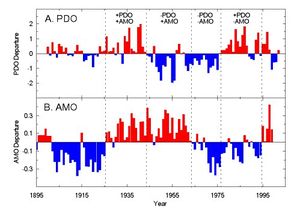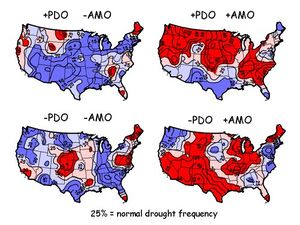Atlantic Multidecadal Oscillation
The Atlantic Multidecadal Oscillation (AMO) is a 65 to 80 year cycle with a 0.4oC temperature range, observed in the North Atlantic Ocean as a sea surface temperature for the period 1856 to 1999.
| This article is written at a definitional level only. Authors wishing to expand this entry are inivited to expand the present treatment, which additions will be peer reviewed prior to publication of any expansion. |
AMO warm phases occurred during 1860–1880 and 1940–1960, with cool phases during 190–1925 and 1970–1990. The signal is global in scope, with a positively correlated co–oscillation in parts of the North Pacific Ocean, although it is most intense in the North Atlantic and covers the entire basin.

During AMO warmings most of the continental USA experiences less than normal rainfall, including Midwest droughts in the 1930s and 1950s. Mississippi River outflow varies by around ten percent between warm and cool phases. The geographical pattern of variability is influenced mainly by changes in summer rain. Winter patterns of interannual rainfall variability associated with ENSO are significantly changed between AMO phases.
Further Reading:
- Physical Oceanography Index
- Pacific and Atlantic Ocean Influences on Multidecadal Drought Frequency in the U.S. Greg McCabe, Mike Palecki, and Julio Betancourt, USGS, 2004
- Pacific and Atlantic Ocean influences on multidecadal drought frequency in the United States., McCabe_ea.pdf McCabe, G. J., Palecki, M. A., and Betancourt, J. L. 2004. Proceedings of the National Academy of Sciences 101, p. 4136-4141.
